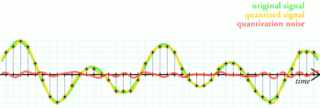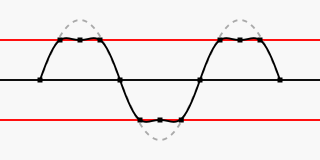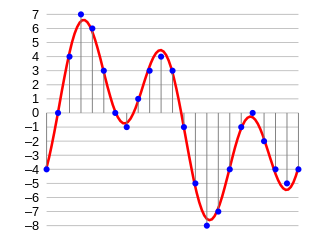
In electronics, an analog-to-digital converter is a system that converts an analog signal, such as a sound picked up by a microphone or light entering a digital camera, into a digital signal. An ADC may also provide an isolated measurement such as an electronic device that converts an analog input voltage or current to a digital number representing the magnitude of the voltage or current. Typically the digital output is a two's complement binary number that is proportional to the input, but there are other possibilities.

Signal-to-noise ratio is a measure used in science and engineering that compares the level of a desired signal to the level of background noise. SNR is defined as the ratio of signal power to noise power, often expressed in decibels. A ratio higher than 1:1 indicates more signal than noise.
The signal-to-noise and distortion ratio (SINAD) is a measure of the quality of a signal from a communications device, often defined as
Sound can be recorded and stored and played using either digital or analog techniques. Both techniques introduce errors and distortions in the sound, and these methods can be systematically compared. Musicians and listeners have argued over the superiority of digital versus analog sound recordings. Arguments for analog systems include the absence of fundamental error mechanisms which are present in digital audio systems, including aliasing and associated anti-aliasing filter implementation, jitter and quantization noise. Advocates of digital point to the high levels of performance possible with digital audio, including excellent linearity in the audible band and low levels of noise and distortion.

In signal processing, sampling is the reduction of a continuous-time signal to a discrete-time signal. A common example is the conversion of a sound wave to a sequence of "samples". A sample is a value of the signal at a point in time and/or space; this definition differs from the term's usage in statistics, which refers to a set of such values.
A numerically controlled oscillator (NCO) is a digital signal generator which creates a synchronous, discrete-time, discrete-valued representation of a waveform, usually sinusoidal. NCOs are often used in conjunction with a digital-to-analog converter (DAC) at the output to create a direct digital synthesizer (DDS).

Quantization, in mathematics and digital signal processing, is the process of mapping input values from a large set to output values in a (countable) smaller set, often with a finite number of elements. Rounding and truncation are typical examples of quantization processes. Quantization is involved to some degree in nearly all digital signal processing, as the process of representing a signal in digital form ordinarily involves rounding. Quantization also forms the core of essentially all lossy compression algorithms.
Noise shaping is a technique typically used in digital audio, image, and video processing, usually in combination with dithering, as part of the process of quantization or bit-depth reduction of a signal. Its purpose is to increase the apparent signal-to-noise ratio of the resultant signal. It does this by altering the spectral shape of the error that is introduced by dithering and quantization; such that the noise power is at a lower level in frequency bands at which noise is considered to be less desirable and at a correspondingly higher level in bands where it is considered to be more desirable. A popular noise shaping algorithm used in image processing is known as ‘Floyd Steinberg dithering’; and many noise shaping algorithms used in audio processing are based on an ‘Absolute threshold of hearing’ model.
In signal processing, oversampling is the process of sampling a signal at a sampling frequency significantly higher than the Nyquist rate. Theoretically, a bandwidth-limited signal can be perfectly reconstructed if sampled at the Nyquist rate or above it. The Nyquist rate is defined as twice the bandwidth of the signal. Oversampling is capable of improving resolution and signal-to-noise ratio, and can be helpful in avoiding aliasing and phase distortion by relaxing anti-aliasing filter performance requirements.

Delta-sigma modulation is an oversampling method for encoding signals into low bit depth digital signals at a very high sample-frequency as part of the process of delta-sigma analog-to-digital converters (ADCs) and digital-to-analog converters (DACs). Delta-sigma modulation achieves high quality by utilizing a negative feedback loop during quantization to the lower bit depth that continuously corrects quantization errors and moves quantization noise to higher frequencies well above the original signal's bandwidth. Subsequent low-pass filtering for demodulation easily removes this high frequency noise and time averages to achieve high accuracy in amplitude which can be ultimately encoded as pulse-code modulation (PCM).

Decibels relative to full scale is a unit of measurement for amplitude levels in digital systems, such as pulse-code modulation (PCM), which have a defined maximum peak level. The unit is similar to the units dBov and decibels relative to overload (dBO).
Signal-to-quantization-noise ratio is widely used quality measure in analysing digitizing schemes such as pulse-code modulation (PCM). The SQNR reflects the relationship between the maximum nominal signal strength and the quantization error introduced in the analog-to-digital conversion.
In telecommunications, the carrier-to-noise ratio, often written CNR or C/N, is the signal-to-noise ratio (SNR) of a modulated signal. The term is used to distinguish the CNR of the radio frequency passband signal from the SNR of an analog base band message signal after demodulation. For example, with FM radio, the strength of the 100 MHz carrier with modulations would be considered for CNR, whereas the audio frequency analogue message signal would be for SNR; in each case, compared to the apparent noise. If this distinction is not necessary, the term SNR is often used instead of CNR, with the same definition.

In digital audio using pulse-code modulation (PCM), bit depth is the number of bits of information in each sample, and it directly corresponds to the resolution of each sample. Examples of bit depth include Compact Disc Digital Audio, which uses 16 bits per sample, and DVD-Audio and Blu-ray Disc, which can support up to 24 bits per sample.
Effective number of bits (ENOB) is a measure of the dynamic range of an analog-to-digital converter (ADC), digital-to-analog converter, or their associated circuitry. The resolution of an ADC is specified by the number of bits used to represent the analog value. Ideally, a 12-bit ADC will have an effective number of bits of almost 12. However, real signals have noise, and real circuits are imperfect and introduce additional noise and distortion. Those imperfections reduce the number of bits of accuracy in the ADC. The ENOB describes the effective resolution of the system in bits. An ADC may have a 12-bit resolution, but the effective number of bits, when used in a system, may be 9.5.
The modulation error ratio or MER is a measure used to quantify the performance of a digital radio transmitter or receiver in a communications system using digital modulation. A signal sent by an ideal transmitter or received by a receiver would have all constellation points precisely at the ideal locations, however various imperfections in the implementation or signal path cause the actual constellation points to deviate from the ideal locations.
Spurious-free dynamic range (SFDR) is the strength ratio of the fundamental signal to the strongest spurious signal in the output. It is also defined as a measure used to specify analog-to-digital and digital-to-analog converters and radio receivers.
Integral nonlinearity is a commonly used measure of performance in digital-to-analog (DAC) and analog-to-digital (ADC) converters. In DACs, it is a measure of the deviation between the ideal output value and the actual measured output value for a certain input code. In ADCs, it is the deviation between the ideal input threshold value and the measured threshold level of a certain output code. This measurement is performed after offset and gain errors have been compensated.
A logarithmic resistor ladder is an electronic circuit, composed of a series of resistors and switches, designed to create an attenuation from an input to an output signal, where the logarithm of the attenuation ratio is proportional to a binary number that represents the state of the switches.
Time interleaved (TI) ADCs are Analog-to-Digital Converters (ADCs) that involve M converters working in parallel. Each of the M converters is referred to as sub-ADC, channel or slice in the literature. The time interleaving technique, akin to multithreading in computing, involves using multiple converters in parallel to sample the input signal at staggered intervals, increasing the overall sampling rate and improving performance without overburdening the single ADCs.









